When it comes to scuba diving the regulator is the essential piece of equipment that really needs to work to dive safely. This is one piece of gear that you want to own and not rent from a scuba shop, especially when diving internationally. There are best practices but there are no laws saying how often a regulator needs to be serviced or inspected. Who knows how old rented regulators are or when the last time they have been serviced.
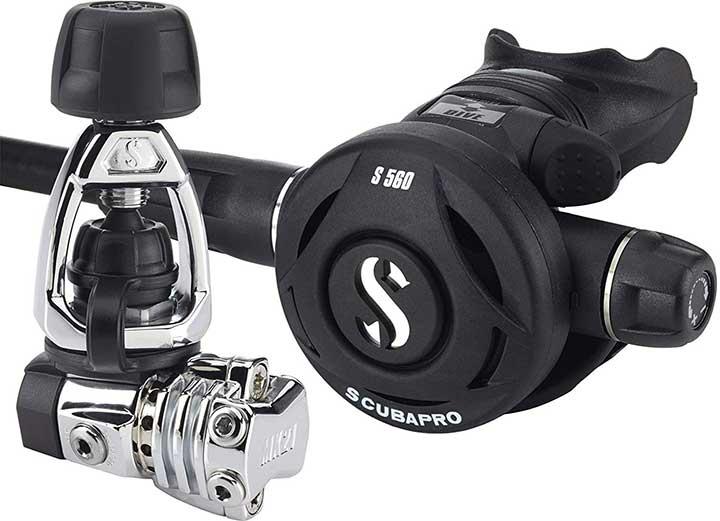
When diving in warm water under 60 feet most regulators on the market will work. Higher-end regulators are sealed and balanced which becomes important when diving deep and when diving in cold water.
Scuba regulators have a first stage and second stage. The first stage is the metal device that attaches directly to the scuba tank via a DIN or yoke connection. Once attached it changes the pressure from high pressure to low pressure that can then be used for breathing from the second stage and inflate the BCD. The second stage controls when the low-pressure air is released via a diaphragm opening which allows the diver to breathe.
When it comes to regulators there are two main connection types a DIN or a yoke. Yoke valves are more common but only work with tanks filled to less than 3000 PSI. DIN vales have fewer o-ring problems and can typically be used with steel tanks up to 3500 psi.
The first stage regulators contain either a piston or diaphragm regulating valve. The system can be balanced or unbalanced. If you want a wireless transmitter to send tank pressure to the dive computer the regulator will need to have two or more high-pressure ports.
Here Are the Best Scuba Diving Regulators
1. Cressi AC2 with XS Compact Scuba Regulator
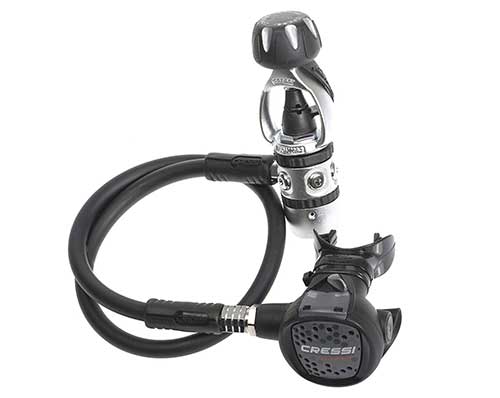
| Valve | Yoke |
| First Stage | Unbalanced |
| HP ports | One |
| LP ports | Four |
| Sealed | No |
| Max Pressure | 3365 psi |
| Breathing Effort | 1.35 J/l |
This regulator is rated number one because it is a low cost, durable regulator that requires little maintenance. For the average diver that dives a few times a year in warm water, this is all that should be needed.
The AC2 first stage is a simple, reliable, and robust unbalanced piston design. It is made with nickel-plated brass. The XS compact second stage has an adjustment for the Venturi effect and a low noise semi-rigid case. An XS compact octopus also makes a great secondary regulator. The durability of this setup is why this regulator is often used as rental gear for dive operations. The average breathing effort is 1.35 J/l.
The Cressi T10 SC Cromo Compact Pro is a higher-end version of this regulator that is good to use when diving in cold water.
Cressi XS Compact Octopus
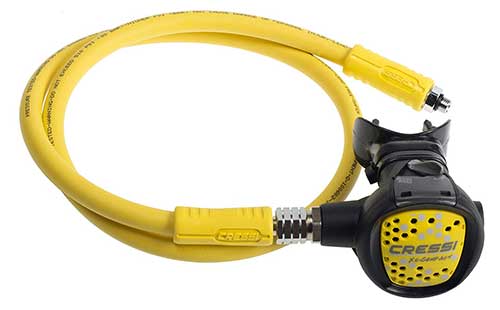
Cressi XS compact octopus is used as the backup regulator for the AC2 first stage. Most regulators only come with the primary second stage, not the octopus. The backup second-stage regulator is referred to as the octopus. In this case, the only difference between the octopus and the primary second stage is the hose and case are yellow to make it clear that it is the back-up. Sometimes the second stage is a lower-cost version of the primary second stage. The octopus is threaded onto a low-pressure port on the primary regulator.
The reason the octopus is yellow is to ensure the primary regulator is being used most of the time. It is important to occasionally use and test the secondary regulator. The yellow color also helps the dive buddy know which regulator they should use in the event of an air issue or low air situation.
Cressi Analog Pressure Gauge
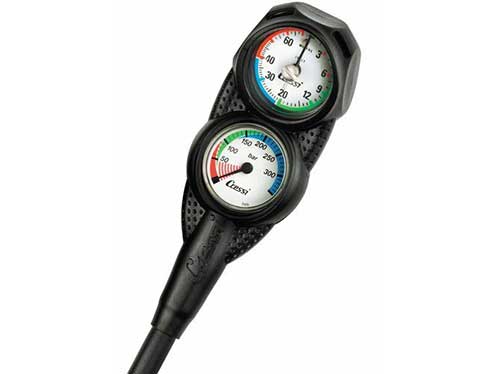
The regulator also needs a pressure gauge or have an integrated dive computer. Having a pressure gauge that also has a depth gauge is a good idea. The depth gauge is available in imperial units which are feet and metric which are in meters. Typically you are going to read the depth from the dive computer. Having a pressure gauge is a must-have when using a wrist dive computer even if it transmits tank pressure. This gauge connects to a high-pressure port on the primary regulator.
Leonardo 2 Dive Computer
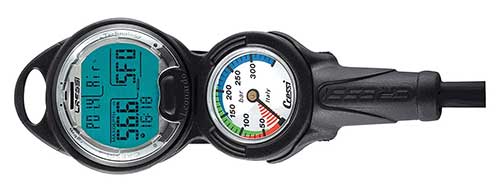
Cressi air gauge with integrated Leonardo 2 dive computer. It is about the same price to get the dive computer integrated with the air or as a separate wrist computer. This equipment is being shown to help decide how many ports are needed on the regulator. Most divers that have an air integrated dive computer that is directly connected to the regulator do not additionally have a submersible pressure gauge (SPG). When using a wrist computer even if it transmits pressure should have an SPG that is directly connected to the regulator. For non-technical diving, many people use a wrist computer with the standard analog air gauge.
Cressi Leonardo Wrist Computer
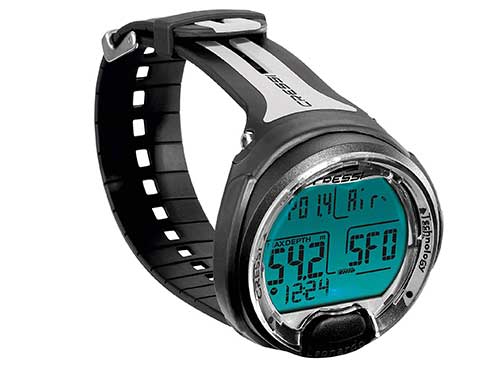
Cressi Leonardo wrist computer. Wrist computers are becoming more and more popular. This is because the computer can be worn like a watch and is easy to check the depth and remaining bottom time values. Having a wrist computer is great for non-technical diving. For technical and deep diving having an air-integrated computer is best since it can more accurately calculate the remaining bottom-time based on tank pressure and safety stops.
2. Cressi XS Compact DIN Regulator
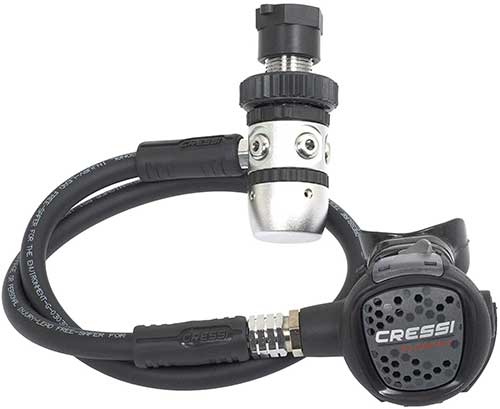
| Valve | Din |
| First Stage | Unbalanced |
| HP ports | One |
| LP ports | Four |
| Sealed | No |
| Max Pressure | 4350 psi |
| Breathing Effort | 1.35 J/l |
This Cressi AC2 with XS compact has a DIN first stage regulator rather than a yoke regulator. The only difference between this regulator and the yoke regulator above is how it is connected to the scuba tank. When using a DIN regulator you need to also have a DIN valve on the scuba tank. Most DIN scuba tanks can also be dived with a yoke regulator if a threaded insert is placed in the valve and the tank is filled to 3,000 psi or less. Yoke scuba tanks can dive with a DIN regulator with a yoke adapter for the DIN tank. The threaded insert and yoke adapter are shown toward the bottom of this article.
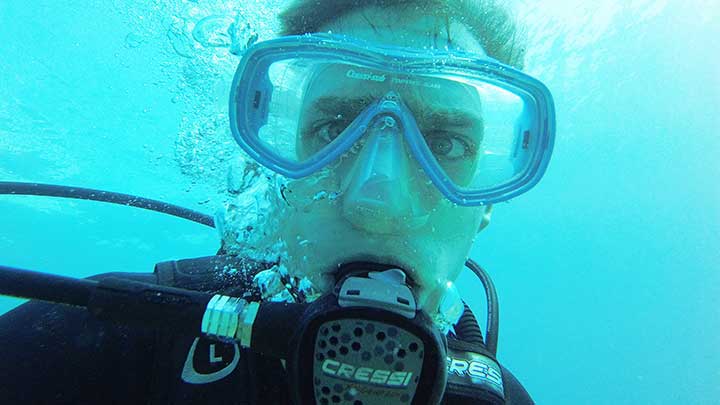
In the picture, I am diving with a Cressi XS compact regulator in the Florida Keys. This is a great regulator for warm water diving.
3. Cressi Ellipse MC9 Scuba Diving Regulator
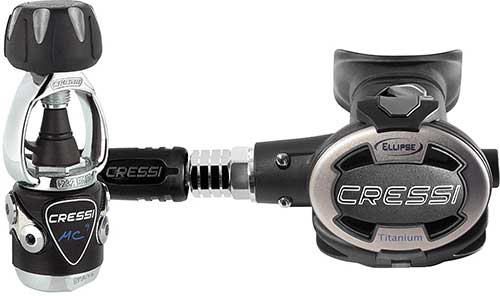
| Valve | Yoke |
| First Stage | Hyper-balanced |
| HP ports | Two |
| LP ports | Four |
| Sealed | Yes |
| Max Pressure | 3365 psi |
| Breathing Effort | 0.6 J/l |
For the diver that wants a little more performance than the AC2, the MC9 is a great option. The MC9 first stage is a hyper balanced diaphragm system. It also has an anti-pressure drop pneumatic spring and high capacity filter. The first stage is made with nickel-plated brass.
A pneumatically balanced second stage has adjustments for the Venturi effect. It also has a low noise rigid case, with a cam-lock. The average breathing effort is 0.6 J/l.
4. Cressi T10 DIN Scuba Regulator
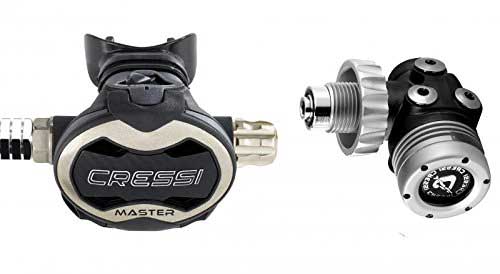
| Valve | Din |
| First Stage | Over-balanced |
| HP ports | Two |
| LP ports | Four |
| Sealed | Yes |
| Max Pressure | 3365 psi |
| Breathing Effort | 0.6 J/l |
If you want to get a high-performance DIN regulator the T10 SC is a great option. The first state is an overcompensation diaphragm design. The regulator has two high-pressure and four medium-pressure ports. It has a sealed first stage that protects the diaphragm from freezing and can be used in cold water environments.
The second stage has pneumatic compensation to regulate airflow rates. It is made with sound-absorbing plastics and corrosion-resistant titanium. The only reason it is number three is that it is more expensive than the regulators above. It has an average breathing effort is .6 J/l.
5. Aqua Lung Leg3nd Yoke Regulator
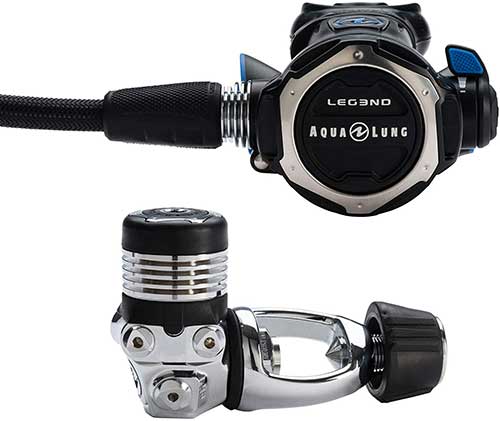
| Valve | Yoke |
| First Stage | Over-balanced |
| HP ports | Two |
| LP ports | Four |
| Sealed | Yes |
| Max Pressure | 3300 psi |
| Breathing Effort | N/A |
This is the third generation of the top quality Aqua Lung Legend Regulator. The first stage is an over-balanced diaphragm design. An auto closer device on the first stage keeps corrosive water from entering the regulator when it is removed from the tank. The regulator had two high-pressure ports and four low-pressure ports. It is made with marine brass and has an exterior chrome coating.
The second stage is pneumatically balanced resulting in a low and consistent breathing effort. It comes with braided Aqua Flex hose. Everything about this regulator is built quality. The comfobite mouthpiece is nice when diving for long periods. It has a large easy to use purge valve and exhaust tree to help disperse bubbles. The overall work of breathing on past Legend models was .74 J/l but is not listed for the third generation.
The aqualung legend regulators are known for being good cold water regulators. This third-generation model is no different. It has dry chambers that reduce the potential for ice build-up. In the secondary regulator, there are large ribs that act as a heat exchanger to protect internal mechanisms. Lastly, there is a cap that helps to protect the diaphragm from ice build-up.
Aqua Lung Leg3nd Octopus
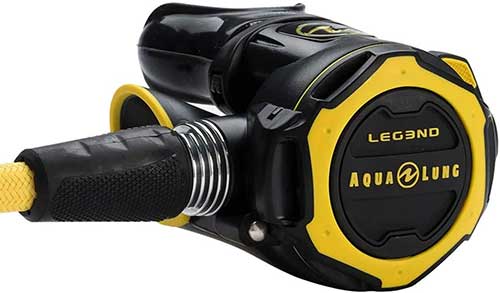
Aqua Lung Leg3nd is the third generation Legend octopus and is a top-quality secondary regulator. It is pneumatically balanced and is designed to work with the Legend’s first stage. An efficient heat exchanger makes it so this octopus can be used in cold water without freezing up in most conditions.
6. Aqua Lung Leg3nd Elite Scuba Regulator
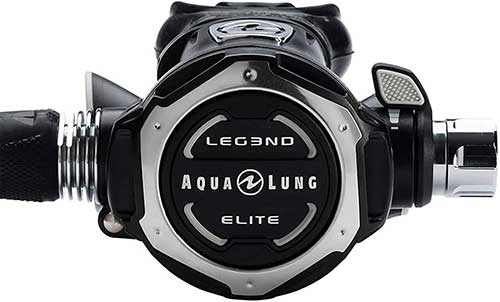
| Valve | Yoke |
| First Stage | Over-balanced |
| HP ports | Two |
| LP ports | Four |
| Sealed | Yes |
| Max Pressure | 3300 psi |
| Breathing Effort | Around .74 J/l |
The Elite is the latest and highest-end model of the Aqua Lung Legend series of regulators. Features of the first stage include the auto closure device, anti-freeze design, auto-balanced design, low breathing effort maintained at deep depths, and soft-grip material for easy regulator removal from the scuba tank.
Key features of the second stage include an over-molded purge cover, comfobite mouthpiece, large heat exchanger, air channel deflector, and flexible light braided hose. The overall work of breathing past legend models was .74 J/l but is not listed for the third generation.
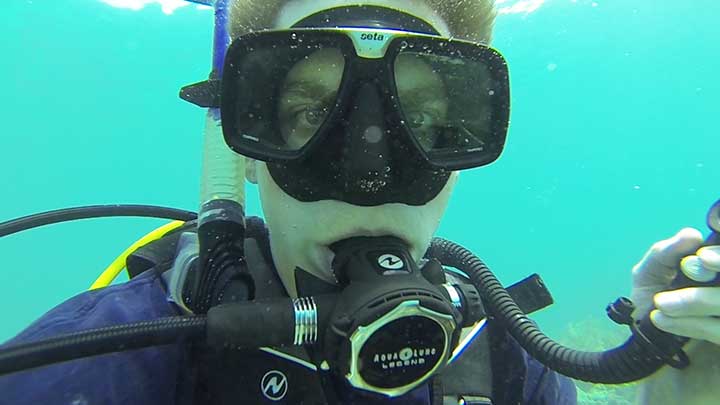
In the picture, I am diving with an aqualung legend regulator. This is a great regulator for basic and advanced diving in warm and cold water environments.
7. Aqua Lung Core Scuba Diving Regulator
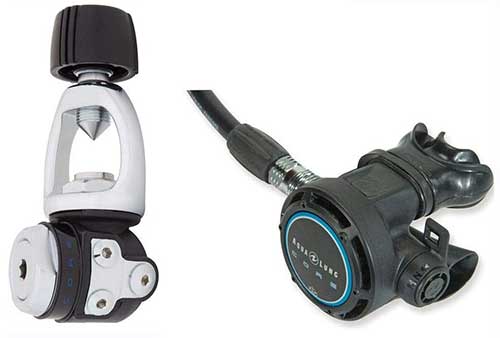
| Valve | Yoke |
| First Stage | Balanced |
| HP ports | Two |
| LP ports | Four |
| Sealed | No |
| Max Pressure | 3300 psi |
| Breathing Effort | 0.6 J/l |
This regulator’s first-stage has the auto closer device and a pneumatically balanced diaphragm for consistent breathing at different depths and tank pressures. It comes in both a DIN and yoke model. Like most regulators, it is compatible with enriched air nitrox EAN up to 40 percent. Its second stage features the comfo-bite mouthpiece and a Venturi knob to control the airflow and breathing effort.
8. ScubaPro MK21 Scuba Diving Regulator
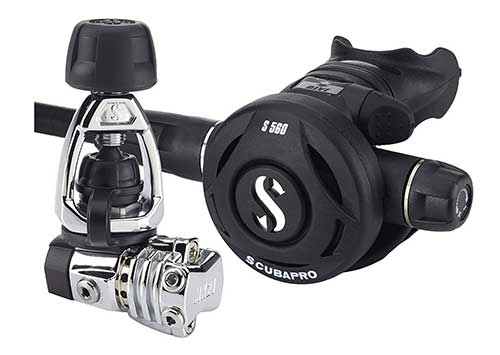
| Valve | Yoke |
| First Stage | Balanced |
| HP ports | Two |
| LP ports | Four |
| Sealed | No |
| Max Pressure | 3300 psi |
| Breathing Effort | N/A |
ScubaPro MK21 regulator has a piston balanced first stage. It comes with two high pressure and four low-pressure ports. There are external fins on the brass regulator which help prevent it from freezing when diving in cold weather conditions.
The second stage has a Venturi-initiated vacuum assist dive or pre-dive switch. It is known for easy breathing regardless of depth. The regulator’s average breathing effort is not published. It has a hose with a large bore diameter which allows for a high airflow rate when inhaling. Finally, there is a comfortable orthodontic mouthpiece with a good grip.
ScubaPro R193 Octopus
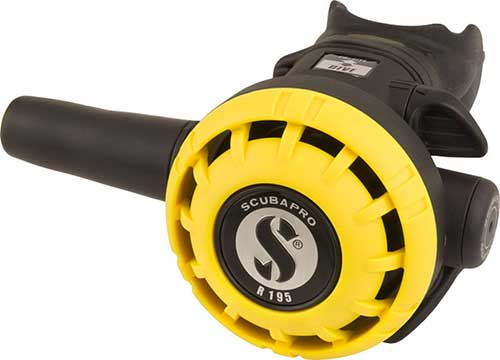
ScubaPro R195 is a great secondary regulator that acts as the octopus. This is a good octopus for most Scubapro regulators. It features a yellow cover, a long hose, and a reversible attachment. There is a flow adjustment valve but it is not a balanced second stage.
ScubaPro Pressure and Depth Gauge
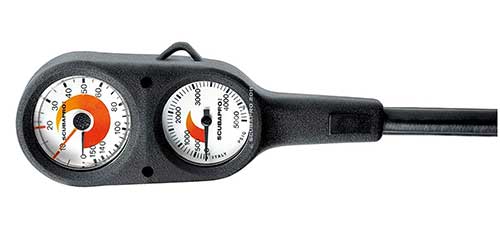
ScubaPro analog pressure and depth gauge. This is an imperial gauge with depth in feet and pressure in psi. Gauges do not have to be from the same company as the regulator but it is common to have matching gear.
9. ScubaPro MK25 EVO Black Tech Scuba Regulator
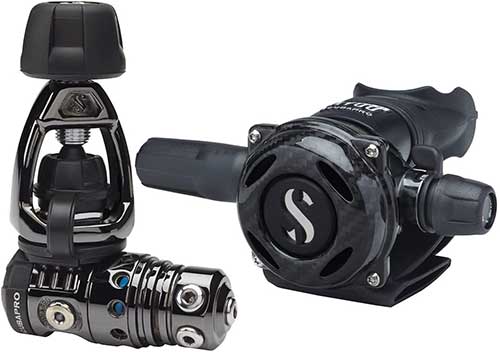
| Valve | Yoke |
| First Stage | Unbalanced |
| HP ports | Two |
| LP ports | Five |
| Sealed | No |
| Max Pressure | 3364 psi |
| Breathing Effort | N/A |
The ScubaPro MK25 A700 EVO carbon black tech is a top-quality durable scuba regulator. Its first stage is a balanced piston design. An extended thermal insolating system delays ice build-up on internal components. High-pressure ports locations allow the regulator to face up or down.
The second stage is made with metal which transfers heat well and carbon fiber which makes the regulator durable and light. It balances air pressure for consistent breathing regardless of depth or tank pressure.
10. ScubaPro MK25 EVO D420 Scuba Regulator
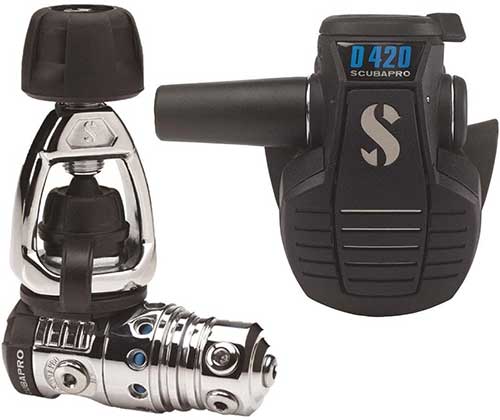
| Valve | Yoke |
| First Stage | Balanced |
| HP ports | Two |
| LP ports | Five |
| Sealed | Yes |
| Max Pressure | 3364 psi |
| Breathing Effort | N/A |
The MK25 EVO D420 is one of the latest scuba regulator models by ScubaPro. It is available both as a yoke and DIN configuration of the first stage. The balanced first stage allows for consistent breathing effort regardless of water depth or tank pressure. Features of the first stage include an extended thermal insulating system, two high-pressure ports for flexible positioning, five high flow low-pressure ports, and external adjustment of intermediate pressures.
When looking at the second stage the first thing people notice is the unique shape. The diaphragm is located in the lower section which makes breathing easier in the upright position. Other features of the second stage include an air balanced progressive flow control valve, dive or pre-dive switch, inner winglets to reduce exhalation effort, and a compact high-flow mouthpiece that is comfortable to wear.
11. ScubaPro MK2 EVO Scuba Diving Regulator
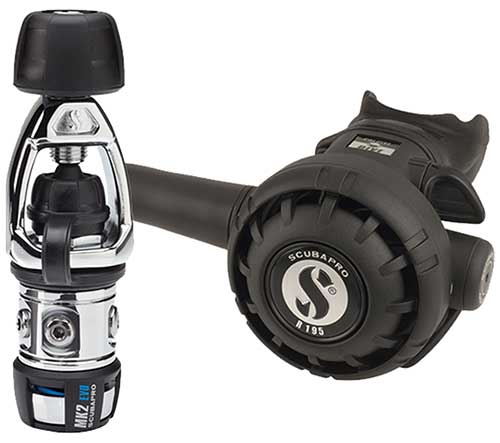
| Valve | Yoke |
| First Stage | Unbalanced |
| HP ports | One |
| LP ports | Four |
| Sealed | No |
| Max Pressure | 3364 psi |
| Breathing Effort | N/A |
The ScubaPro MK2 EVO is a scuba regulator with an unbalanced piston first stage. This is a durable regulator with good airflow performance. Features of the first stage include a large piston, extended thermal insulation system, and a removable orifice.
Key features of the second stage include an adjustable Venturi vacuum assist, a super flow hose, a comfortable mouthpiece, and metal valve housing. There are over 12 different models of ScubaPro regulators. This is a common R-series model and the T-195 second stage is commonly used as the octopus on higher-end models as well.
12. Atomic Aquatics T3 Titanium Scuba Regulator
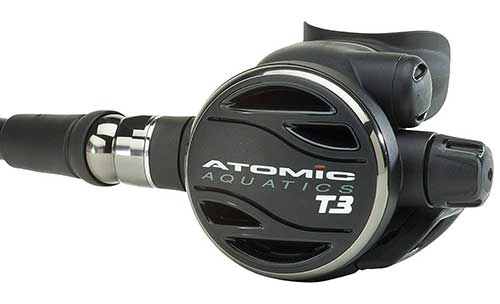
| Valve | Yoke |
| First Stage | Balanced |
| HP ports | Two |
| LP ports | Five |
| Sealed | Yes |
| Max Pressure | 3365 psi |
| Breathing Effort | N/A |
If cost is not a factor the T3 is the best regulator on the market. The regulator has a three year 300 dive service interval. The first stage and second stage components are milled from a solid bar of Titanium. This is a sealed piston first stage with two high pressure and five low-pressure ports.
The first and second stage weighs under 1.8 pounds which makes it the lightest regulator in the world. Average breathing effort is not published. A key feature of the regulator is the automatic flow control that regulates the Venturi effect when diving deeper.
The second stage is pneumatically balanced and maintains the same breathing effort even as depth and tank pressure changes. An elliptical exhaust valve allows for easy exhales. A comfort-fit silicone mouthpiece is soft and has tear-resistant bite tabs. The regulator has a patented comfort swivel which is shown in the video below. This allows for 30 degrees of motion without the hose needing to rotate.
Atomic Aquatics Z2 Octopus
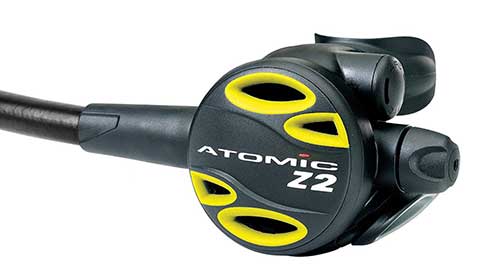
Atomic Aquatics Z2 octopus as the secondary scuba regulator. This is colored yellow to signify that it is the secondary regulator. It also comes with a long 36-inch hose. The Atomic Z2 Octopus is the same as the Z2 primary second stage which is a top-quality regulator. Features include zirconium-plated brass and titanium components as well as the patented automatic flow system.
13. Atomic Aquatics B2 Yoke Scuba Regulator
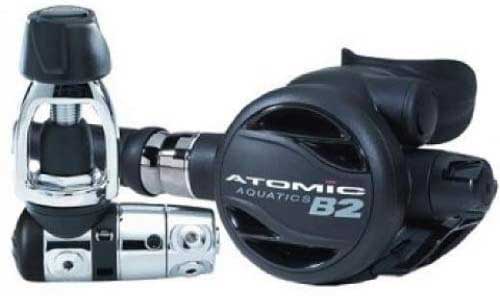
| Valve | Yoke |
| First Stage | Balanced |
| HP ports | Two |
| LP ports | Five |
| Sealed | Yes |
| Max Pressure | 3365 psi |
| Breathing Effort | N/A |
This is a top-quality regular that is made with brass and titanium components. The entire regulator weighs just 2.5 pounds. Features of the first stage include a jet seat high flow piston, factory sealed, and nitrox ready.
The second stage is pneumatically balanced to maintain breathing effort at different depths and tank pressures. Key features of the second stage include the patented automatic flow control, seat saving dynamic orifice, elliptical exhaust valve, and comfort fit mouthpiece.
14. Oceanic ZEO DIN Regulator with Maxflex
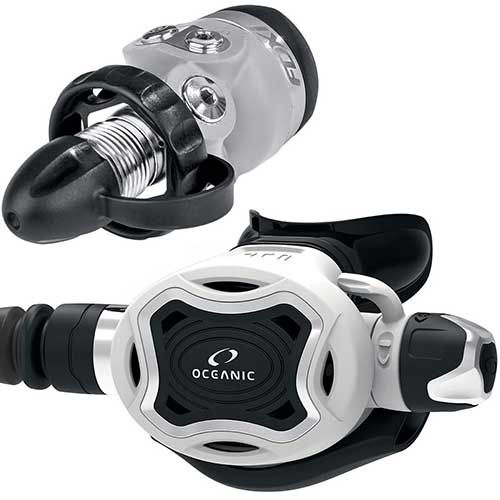
| Valve | Din |
| First Stage | Balanced |
| HP ports | Two |
| LP ports | Four |
| Sealed | No |
| Max Pressure | 4300 psi |
| Breathing Effort | 0.86 J/l |
The Oceanic Zeo DIN regulator is an improvement to the EOS which is a popular regulator. Features of the FDX-i first stage include chrome-plated marine brass construction, pneumatically balanced, and environmentally sealed.
The second stage is also pneumatically balanced. There is also a knob that allows the diver to change the breathing effort. An adjustment Venturi switch allows the regulator to be set at pre-dive or dive settings. The inline ball swivel and orthodontic mouthpiece help fit the regulator in a comfortable way. This regulator is good for cold water or warm water diving.
15. Oceanic Alpha 10 SPX Scuba Regulator
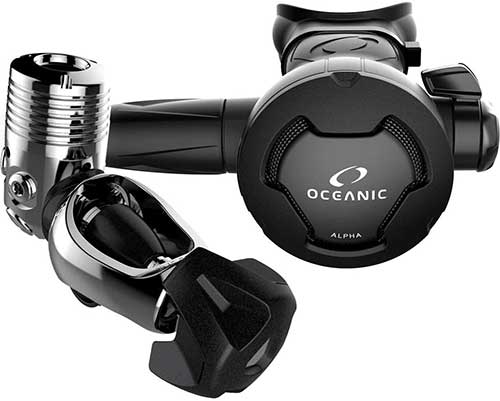
| Valve | Yoke |
| First Stage | Unbalanced |
| HP ports | Two |
| LP ports | Four |
| Sealed | No |
| Max Pressure | 3300 psi |
| Breathing Effort | N/A |
This regulator has an unbalanced piston first stage design which is known to be simple and reliable. It is not balanced so the breathing effort may vary with water depth and scuba tank pressure. The first stage is made the chrome coated marine brass. It does come nitrox ready up to 40 percent.
The second stage is pneumatically balanced which helps keep the breathing effort constant throughout the dive. Key features of the second stage include Venturi dive or pre-dive settings, and an orthodontic mouthpiece. This regulator is made in the USA.
16. Mares Rover 2S Scuba Regulator with Octopus
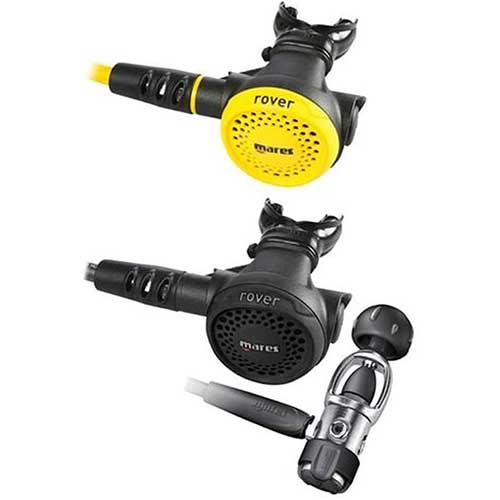
| Valve | Yoke |
| First Stage | Balanced |
| HP ports | One |
| LP ports | Four |
| Sealed | No |
| Max Pressure | 3300 psi |
| Breathing Effort | N/A |
This regulator’s first stage is a balanced piston design. It is made with marine-grade brass. There is a location on the regulator for RFID chips to help keep an inventory of rental gear at dive shops.
Features of the second stage and octopus include a mesh grid to reduce the impact of water on the diaphragm, vortex assisted design for easy consistent breathing, and dynamic flow control to help maintain pressure during inhalation. A durable lightweight polymer is used for the shell of the regulator and is good for warm water diving. It does not transfer heat well for cold water diving. The octopus is included in the dive package.
17. Cressi AC2 Piston Scuba Diving Regulator
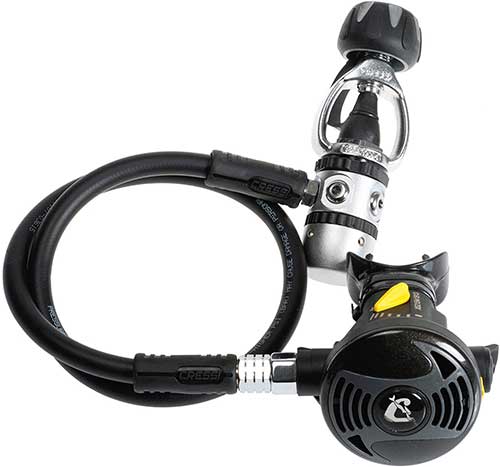
| Valve | Yoke |
| First Stage | Unbalanced |
| HP ports | One |
| LP ports | Four |
| Sealed | No |
| Max Pressure | 3365 psi |
| Breathing Effort | 1.35 J/l |
This Cressie regulator has the position driven AC2 first stage and the XS2 second stage. This is a low-cost reliable regular that is popular for a primary regulator and the XS2 in yellow is common as an octopus in warm water scuba locations. Its first stage is robust and requires little maintenance. There is a conical filter on the first stage which helps prevent any large particles in the scuba tank from entering the first and second stages of the regulator. The low-pressure value can be adjusted with an exterior Allen key screw.
A flow deviator on the second stage acts to control the Venturi effect with a dive or pre-dive setting. The second stage is made of a durable polymer that is lightweight. It is not a balanced system and does not have a high heat transfer rate for cold water diving. This is a decent regulator for warm water diving in under 60 feet of water. The Cressi AC2 is also available with the XS compact second stage and is rated number one on this list.
DIV vs Yoke regulators.
The first choice needed to be made when purchasing a regulator is whether to get a DIN or a yoke regulator. Most regulators can be converted from a DIN to a Yoke or vise versa but converting the regulator from one to the other cost about $100.
In the USA and in North America most divers have yoke regulators and yoke valve scuba tanks. The rest of the world is dominated by DIN tanks and regulators. My advice would be if you know you are only going to be doing basic warm water diving in the USA then buy a yoke regulator. If you think you will be diving outside the USA or doing technical diving purchase a DIN regulator. If you do purchase a DIN regulator I would get the yoke adapter and use this when diving with dive shops in the USA. Dive shops in the USA do not like dealing with DIN tanks and regulators.
DIN regulators are the better regulators for two technical reasons. First, some DIN regulators are rated to hold about 1,000 more PSI than yoke regulators. This is because the connection of the yoke regulator is the weak point. Second, the o-ring seal on a DIN tank is within the regulator and typically has fewer issues than yoke tanks external o-rings. It is very common after a few dives to have a bad o-ring that leaks on a yoke valve scuba tank. It is not a big deal but is a small hassle to change the o-ring when it is leaking.
DIN to Yoke Scuba Regulator Adapter by Promate
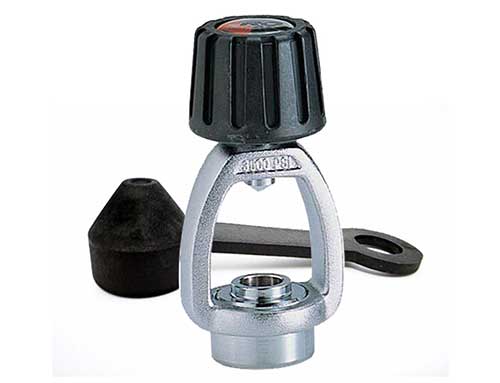
The adapter above allows for a DIN scuba regulator to be used on a scuba tank that is set up for a yoke valve. Many advanced divers want to use DIN scuba regulators and DIN valve scuba tanks when possible. However, when diving on vacation traveling with scuba tanks is not very practical. Dive shops at the destination may not have DIN valve scuba tanks available for rental. They also likely will not have this adapter. It is up to divers with DIN regulators to have this adapter. Even if you think you will never need it it is good to have just in case.
When using this attachment the scuba tank should be filled to a max pressure of 3,000 psi. Just because your regulator is rated to a higher value does not mean that the entire system is rated for the high-pressure value. The yoke connection is often the limiting factor that determines the max pressure that can be safely used while scuba diving.
Plug Adapter for a DIN Scuba Tank to Yoke Regulator
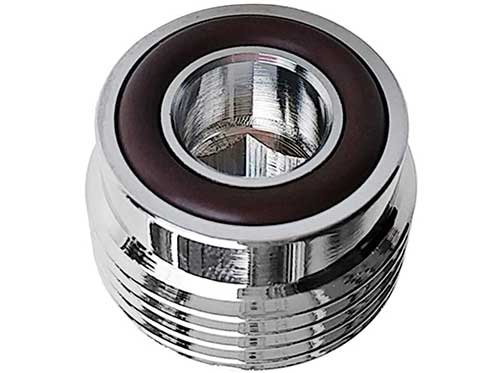
This is a plug adapter that threads into a DIN scuba tank. It is installed with an 8mm hex Allen key tool that is not included. Once installed the DIN tank will fit a yoke scuba regulator. Make sure to not fill the tank above 3000 psi as that is the pressure rating for most yoke regulators.
Scuba Diving Gear
Having a good mask is very important when scuba diving. Once you get good at scuba diving, spearfishing can make diving more interesting. Even if you do not like to fish getting rid of the lionfish on the reefs is beneficial to the ecosystem.
Frequently Asked Questions
What is better a balanced or unbalanced regulator?
The first and second stages can both be balanced or neither can be balanced. Unbalanced systems are simple and reliable. A balanced first stage makes it easier to breathe when at deep depths and when the tank pressure is reduced. A balanced second stage makes it easier to breathe at deep depths. Personally, I have dove wrecks at about 100 feet with an unbalanced regulator and did not notice any change in the force level it took to breathe. The advantage of a simple unbalanced position design is there is typically less required maintenance. Some regulators need to be serviced every year and others need to be serviced every few years. Always check the owner’s manual for the maintenance schedule of the regulator.
Who makes the best scuba regulator?
There are many good brands of scuba regulators such as Cressi, ScubaPro, Oceanic, Aqualung, and Atomic Aquatics. All of these brands have high-end and low-end models. It can be a bit overwhelming trying to figure out which brand and model regulator is the best to purchase. Personally, I think Cressi regulators are of good value and work great for most recreational diving.
For high-end regulators, I like the Aqualung Legend which I own, and the Atomic Aquatics T3 Regulator which is probably the best regulator on the market today if the cost is not a factor. Higher-end models are environmentally sealed and balanced. These are important factors when diving deep and in cold water areas. Also, more expensive modes have more high-pressure and low-pressure ports which are important when adding extra gauges and equipment like dry suits which require an additional low-pressure port.
What is better and DIN or a yoke?
A DIN regulator is considered the better regulator in most cases. DIN regulators can be rated to a higher pressure value than a yoke valve which is also called an A-clamp. Some DIN regulators are actually only rated to 2900 psi so make sure to check the regulator’s pressure rating before use. DIN regulators that can hold more pressure will have more threads that screw into the scuba tank. DIN regulators also have the 0-ring that makes the regulator tank seal within the regulator. This causes fewer air leaks than having the o-ring on the scuba tank valve and is considered a better design by most people.
The reason yoke regulators are mostly used is that most scuba tanks in the USA are made for yoke regulators. If you buy your own DIN tanks than this is not a problem. Most DIN regulators can hold pressures up to 4300 PSI. However aluminum scuba tanks are only rated to 3,000 psi. Steel tanks can be rated up to 3500 psi but are commonly filled to 3,300 psi. The reason many people do not use DIN regulators and steel tanks is that some scuba shops will only fill the tanks to 3,000 psi anyway defeating the purpose of having a setup that can hold higher pressure.
The reason some scuba shops only fill to 3,000 psi is that this is the most common pressure used. Having a compressor that fills a higher value requires a more complex system and the risks that lower pressure tanks will accidentally be filled to a higher value.
What is the first stage and the second stage of a scuba regulator?
The first-stage regulator is the part that is screwed onto the scuba tank. It has at least one high-pressure output port to measure the pressure in the tank with a manual gauge or a dive computer. The first stage will also reduce the tank’s pressure to around 140 psi for low-pressure ports that can be used at the second stage regulator, octopus, BCD inflator, and drysuit. A balanced first stage adjusted the low-pressure output to be consistent at deep depths and varying tank pressures.
The second stage regulator is the part the diver breaths from. There is always a primary second stage and a secondary second-stage or octopus. The secondary second stage is either a duplicate second stage that is yellow or a second stage regulator that is built into a BCD. The second stage always has a purge valve to blow air in the event the regulator needs to be placed back into a diver’s mouth underwater. It also typically has two Venturi settings for pro-dive and driving conditions. The pre-dive setting requires more force when breathing but the regulator is less likely to free-flow. The dive setting is for when the regular is in the diver’s mouth and requires a lower breathing effort. Second stage regulators can also be balances to help keep the breathing force consistent as depth changes.
How do you breathe with a regulator?
Breathing through a scuba regulator is very simple and not much different from breathing above water. The regulator mouthpiece is placed in the mouth and the diver breathes in and out like normal. It is slightly more difficult to inhale and exhale but when diving this is not even a conscious thought. The diver must breathe from the mouth and never hold their breath. This is the number one rule of scuba diving to never hold your breath. If the diver does hold their breathe and is ascending it could cause lung over-expansion which can be fatal.
It is important to breathe out of the nose when descending to equalize the pressure in the mask. If the regulator falls out of the diver’s mouth the diver should exhale to not hold their breath. Since there will not be air in the lungs to clear the regulator of water their is a purge valve that blows air into the diver’s mouth to clear the regulator and mouth of water.
How much PSI does a scuba tank have?
There are several types of scuba tanks that have different pressure ratings. The most common scuba tank used in recreational diving in the USA is an aluminum cylinder that is rated at 3,000 psi. There are also low-pressure steel tanks that are rated between 2,400 and 2,640 psi. High-pressure steel tanks are rated to hold between 3,300 and 3,500 psi. Before any tank is filled the VIP date, Hydro date, and tank pressure rating should be checked. When using a steel tank with a yoke regulator the diver should make sure the tank was not filled above 3,00 psi.
Can you use a DIN regulator on a yoke valve?
A DIN regulator can not be used with a yoke valve scuba tank unless the regulator has an adapter. The adapter threads onto the regulator and have a yoke valve that can attach to the scuba tank. A DIN valve can work with a yoke regulator if a plug adapter is placed into the scuba tank. If you have a DIN regulator and plan to dive on vacation it is important to have an adapter as many scuba shops only provide scuba tanks setup for yoke valve scuba regulators.
How do you clean a scuba regulator?
When cleaning a scuba regulator the first thing to do is to place the dust cap on the regulator. Next, the regulator should be rinsed with fresh water. This can be done by spraying the regulator or dunking it into a tub of fresh water. Do not submerge the first stage of the regulator into the water for a long period because water could get past the dust cover. If it is rental equipment the mouthpiece can also be sanitized with mild disinfectants.
What is a scuba octopus?
The scuba octopus is a backup of the second stage regulator. The cover of the regulator and the hose are typically yellow to let the diver and the diver buddy know that it is the backup regulator. It is common for the octopus to have a long 36-inch hose which is helpful when sharing air with a buddy. The octopus could be an identical secondary regulator that is yellow or a lower-cost regulator with fewer features. It is required to have a secondary regulator when scuba diving. The secondary regulator is sometimes built into the BCD. When doing deep and technical diving it is also common to have a third regulator on a small backup scuba tank called a pony bottle.
What piece of equipment should never be allowed to dangle freely?
The octopus which is the backup second stage regulator should never dangle freely. This is for two reasons. First, it should be secured in a location where the diver can reach it all times even without wearing a mask. Having it in a secure location is also helpful if a buddy needs to use the regulator. Second, the regulator dangling could damage coral or damage the regulator. When diving the pressure gauge and dive computer should also be secured and not dangling.
How often should I check my scuba cylinder?
Scuba tanks need to be visually inspected every year and have a properly dated VIP sticker to be filled. The tank also needs to have a proper hydrostatic test date which is typically every two to five years depending on the type of tank. In addition to these checks, the tank condition and valve conditions should be checked before each use. If the tank pressure ever falls below around 300 psi the tank should also be visually inspected as seawater could have entered the tank. Working at a dive shop I have seen several tanks that ended up with significant water in them because the tank pressure was emptied during a dive.
Scuba Diving Videos
In the video below I am scuba diving a wreck in the Florida keys with some friends and encounter a large great white shark.
In the video below my friends and I are scuba diving at Looe key in the Florida keys at night. Scuba diving at night is a very fun experience.
Captain Cody has worked on charter fishing boats in the Florida Keys, Virgin Islands, and Alaska. Growing up in Pennsylvania Cody has also done extensive freshwater fishing including bass fishing tournaments. Cody strives to provide detailed information about the best fishing gear and tactics to help both novice and experienced anglers have a more productive and enjoyable time on the water. Cody also has a background in aerospace engineering and neuroscience but really only takes pride in being good at one thing and that is fishing!
